Introduction
Dual-band extenders, as their name implies, have the ability to extend both 2.4 GHz and 5 GHz vs. the single-band extenders we looked at that just extend 2.4GHz. Within that category, there are differences however. The RE2000 we tested is what is called “Selectable” dual-band, which basically means you can choose either 2.4 GHz or 5 GHz, but not both at the same time. The RE2000 v2, which is scheduled to ship in late December, will be simultaneous dual-band. All of our other dual-band extenders in this roundup are concurrent / simultaneous dual band.
For the sake of the review, I wanted to look at all dual-band extenders, even if it means revisiting the RE2000 that was featured in the single-band N300 roundup. Below is the list of the dual-band extenders we tested. (Prices shown are as of the review date. Click on the price to get the latest Amazon pricing.)![]()
| Product | Price | Firmware | Chipset | FCC ID | Dual band spec |
|---|---|---|---|---|---|
| Linksys RE2000 | $77 | 1.0.01, build 7 | Ralink RT6856 (processor) + Ralink RT5592 | XU8TEW737HREQ87-RE2000 | Selectable dual band |
| Edimax EW-7238RPD | $50 | 1.14 | Realtek RTL8196CS (processor) + Realtek RTL8192DR | NDD9572381208 | Concurrent dual band |
| Amped Wireless SR20000G | $140 | v2.5.2.39 | Realtek RTL8198 (processor) + RTL8192DR + Realtek RTL8192CE | ZTT-SR20000G | Concurrent dual band |
| NETGEAR WN2500RP | $99 | V1.0.0.30_1.0.58 | Broadcom BCM5358UB0 (processor & 2.4 GHz radio) + Broadcom BCM43236B (5 GHz radio) | PY311300171 | Concurrent dual band |
| NETGEAR WN3500RP | $129 | V1.0.0.18_1.0.59 | Broadcom BCM5358UB0 (processor & 2.4 GHz radio) + Broadcom BCM43236B (5 GHz radio) | PY312300208 | Concurrent dual band |
Table 1: The Products Tested
Inside and Features
As the table shows, the five extenders use four different devices from three chipset vendors. I’m not including internal pictures of each extender, but the FCC product search links are above if you’d like to take a look for yourself.
The single band extenders we looked at were all just basic extenders, with an Ethernet port if you wanted to use it as a bridge (the D-Link DAP-1320 has no Ethernet). In the dual-band arena, we see some additional features for a bit more differentiation but with higher price tags.
For instance, the Amped Wireless SR20000G is the only extender with Gigabit ports, and five of them, no less. The NETGEAR WN2500RP has a built-in four-port 10/100 switch. And both the Amped Wireless SR20000G and the NETGEAR WN3500RP have USB ports for media and printer sharing. The Amped also supports four SSID’s on each band.
The WN3500RP has an audio-out port for AirPlay music streaming, a nice touch to bring audio to a hard-to-reach area. And lastly, both the WN2500RP and WN3500RP incorporate what NETGEAR calls "Fast-Lane" technology. This essentially lets you use one band to communicate from the extender to the router and the other band to communicate from the client to the extender, getting rid of the half throughput penalty that plagues extenders.
All extenders, except for the Linksys RE2000, offer an Extender SSID. The Extender SSID lets you specify a different SSID for the extender so you can know which device you are connected to. That’s important because the extender will be sitting at the edge of your wireless good zone where it can still get good throughput back to the router. You don’t want to be connected to the extender and getting half the throughput that you see using an extender when you are in your good wireless coverage area.
Results – 2.4GHz Bridge
You can see the nitty gritty details of our testing process in How We Test Wireless Extenders. An important thing to note is that we weren’t going for top throughput and the test results don’t represent the highest throughput you can get from these products. Instead, we focused on tests that were free of interference from neighboring networks and that provided an accurate measure of relative performance. This required that we reduce the signal from the router being extended so that we could keep our "dead spot" within the confines of my home and away from interference from the other networks in my overcrowded 2.4 GHz airspace.
On 2.4 GHz, we were working with roughly 42 Mbps downlink and 56 Mbps uplink throughput available for the extender to pass along. Note that those are throughput numbers measured using the test laptop at the extender location.
For each device, I tested performance at the Ethernet port, essentially using it as a bridge, before going on to extender testing. Let’s see how the devices rank used as bridges.
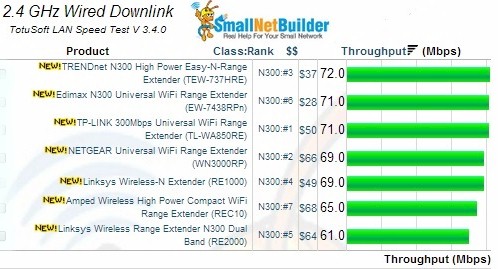
2.4 GHz Wired Downlink Results
You can see that on downlink, the Amped Wireless SR20000G is out front with double the throughput of the next closest extender and almost double the throughput of my laptop. The others all come in fairly close to each other, with the exception of the Edimax. Now let’s look at uplink.
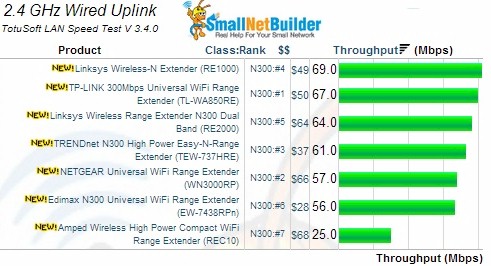
2.4GHz Wired Uplink Results
On uplink the Amped Wireless SR20000G is the clear winner again, with a better showing than the 56 Mbps I saw with my laptop. The NETGEAR WN3500RP does close the gap slightly. There is a rather wide variation here among extenders.
Results – 2.4GHz Extender
Once in extender mode, we’d expect about 50% throughput at best, and that’s about what we saw. The image below shows the comparison of all the dual-band extenders for 2.4 GHz downlink.
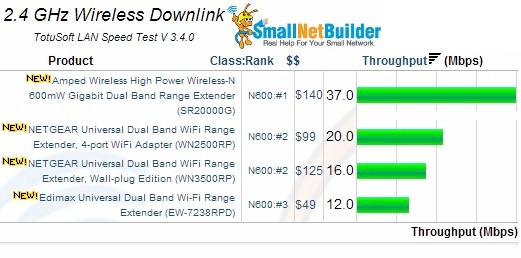
2.4GHz Wireless Downlink Results
Again, the Amped Wireless SR20000G is on top with nearly double the throughput of the next closest competitor and 49% of its wired throughput. The Edimax comes in last with a third of the throughput of the top competitor and half of the second place competitor. Let’s look at uplink.
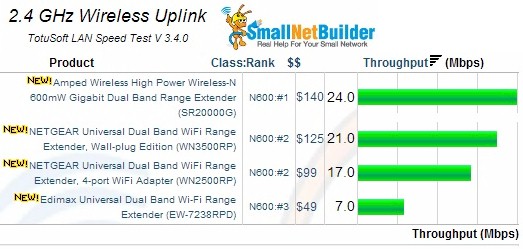
2.4GHz Wireless Uplink Results
2.4 GHz uplink seems to provide a much more level playing field. You can see that all extenders are very close, with the exception of the Edimax. Percentage of wired throughput ranges from 36% and 37% for the Amped Wireless and Edimax respectively, to exactly 50% for the WN3500RP and 53% for the Linksys and WN2500RP.
Results – 5GHz Bridge
On 5 GHz I saw roughly 72 Mbps downlink and 79 Mbps uplink throughput available with my laptop for the extender to pass along. We’ll add the Linksys RE2000 in here for comparison sake. Let’s look at how each extender did on downlink while being used as a bridge.
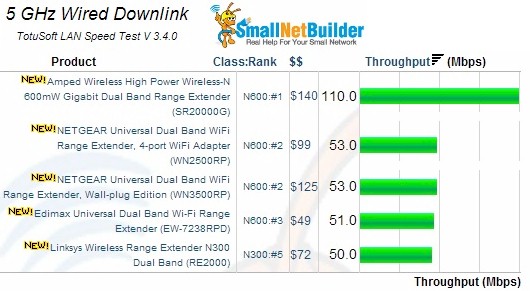
5GHz Wired Downlink Results
The Amped Wireless SR20000G again has nearly double the throughput of the other extenders. It’s the only extender with Gigabit ports, and it did exceed the capacity of a 10/100 port. The rest of the extenders are all very similar. Let’s look at uplink.
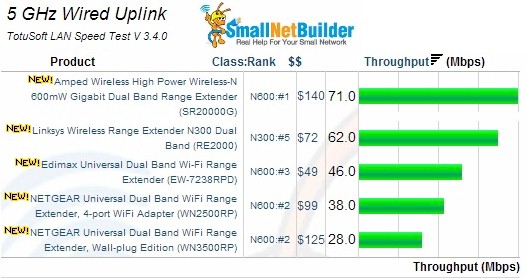
5GHz Wired Uplink Results
5 GHz uplink shows much more variation. The SR20000G is on top again, but it’s followed by the Linksys, the Edimax and the two NETGEARs are last. The placing is definitely a change from what we’ve seen so far. Remember that these devices usually are used as extenders and not bridges, so let’s see how they did in extender mode.
Results – 5GHz Extender
Again, in extender mode we’re hoping for about 50% throughput at best. This is where the results got surprising. Let’s take a look at 5 GHz downlink first.
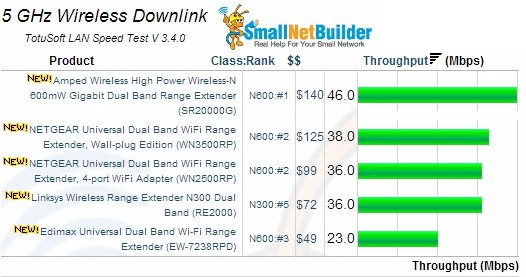
5GHz Wireless Downlink Results
All devices are relatively close to each other, the SR20000G is on top again, however it sees 42% of its wired throughput. The Linksys and two NETGEARs show an unexpected 70% of their wired throughput. Let’s look at uplink.
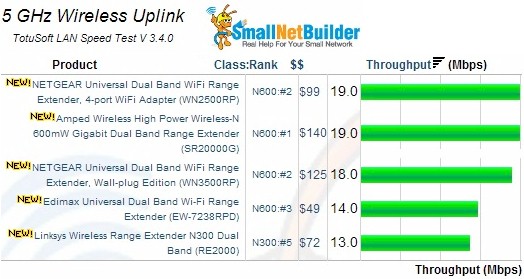
5GHz Wireless Uplink Results
5 GHz uplink shows a very consistent throughput range for all of the extenders, but a very inconsistent percentage of reduction of wired throughput. In the real world, you wouldn’t be able to tell the difference between these extenders in uplink throughput in extender mode.
Results – Fast-Lane
"Fast-Lane" technology is something found only in the NETGEAR extenders. As described above, the technology lets you use one band (and radio) to communicate from your client to the extender, and the other band (and radio) to communicate from extender to router. Since we greatly reduced the throughput we had to work with at the extender location with attenuators, the numbers for Fast-Lane may not look at all that impressive. In normal operation, you might see much better.
I set up Fast-Lane to link back to the router with the 5 GHz band and to my client with the 2.4 GHz band. We can expect that we are going to be looking at roughly the throughput that we saw for 2.4 GHz wired since it’s the slower of the two. Downlink was 42 Mbps and uplink was 33 Mbps, which is about what we saw for the wired 2.4 GHz bridge throughput numbers.
Let’s do a by-the-numbers comparison to the top-ranked SR20000G. For downlink, the SR20000G still just beats Fast-Lane with 46 Mbps. This ratio would correlate to the numbers I can see back to the router from my laptop with attenuators off, 2.4 GHz throughput is just over half of what I see for 5 GHz in a normal situation. The Fast-Lane 33 Mbps for uplink is the best we see for uplink however, with the SR20000G giving us 19 Mbps there.
For me, the verdict is still out on Fast-Lane, especially with the crowded 2.4 GHz spectrum. If you can extend 5 GHz and extend it well, that may be just as good as using Fast-Lane.
Closing Thoughts
It’s no surprise that the Amped Wireless SR20000G ranked #1 among the N600 class extenders tested. It was followed by the two NETGEARs in a tie, and then the Edimax.
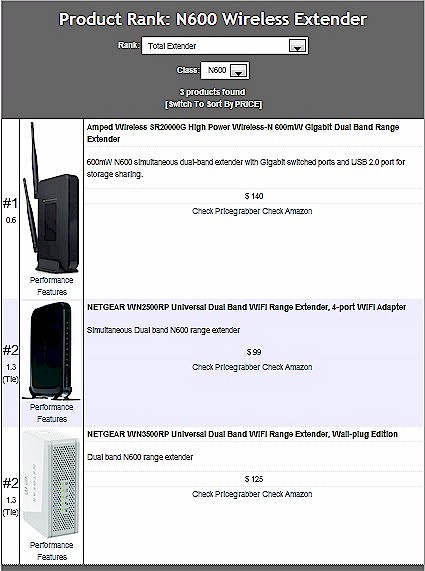
Wireless Extender Ranker – N600
It’s possible the reason for the Edimax’ poor showing is its use of a Realtek RTL8192DR as its sole radio. Since there is no datasheet available for this device and its Realtek RTL8196CS has no radio, we initially thought the EW-7238RPD was not a concurrent dual-band product.
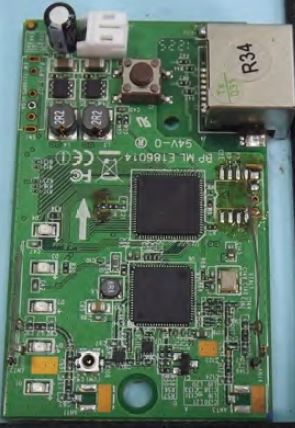
Edimax EW-7238RPD board
After a few back-and-forths with Edimax and manually linking it instead of using WPS, we convinced ourselves that it is indeed an N600 simultaneous dual-band extender. But since it is the only product in this roundup to use this unique device as its only radio, there could be a link to its poor showing.
On the other hand, the Amped SR20000G is the only product in the round-up with a separate processor, two radio devices, plus external amplifiers for both bands. Coincidence that the Amped performs much better than the Edimax? We think not.
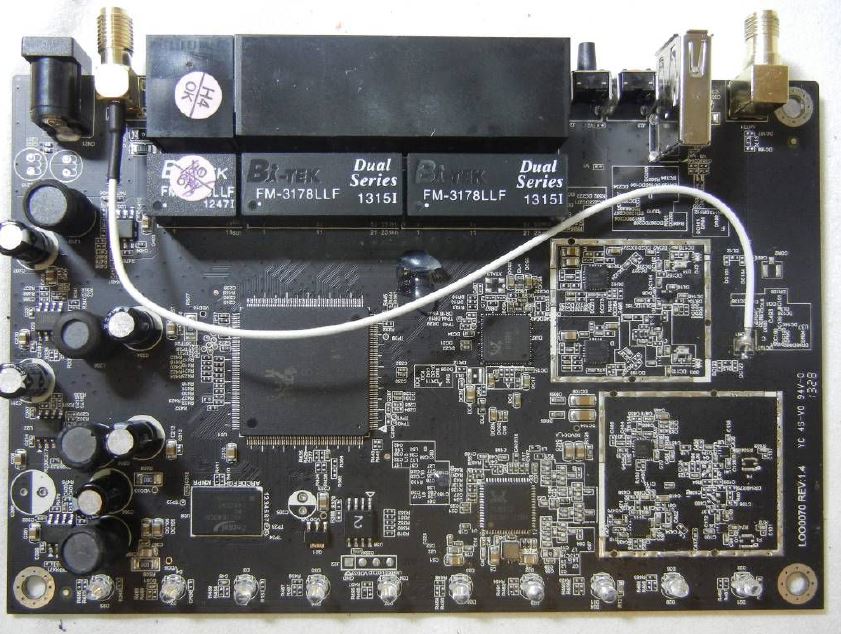
Amped SR20000G board
Here is the performance summary for the top-ranked Amped Wireless SR20000G. Check the Wireless Extender Ranker for details on the other products’ performance.
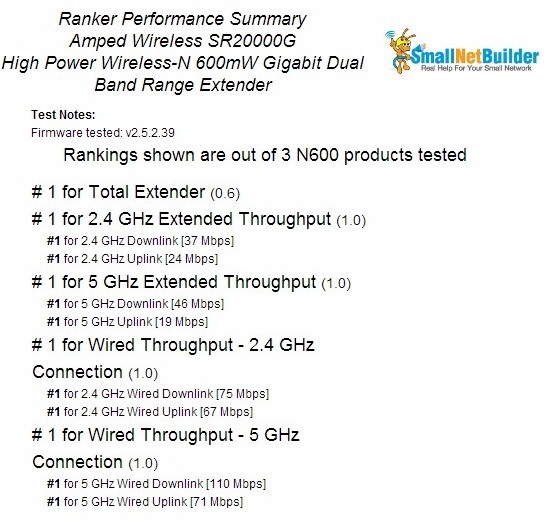
Amped Wireless SR20000G Performance Summary
The concept behind simultaneous dual-band extenders is intriguing. But the optimal spot for 2.4 GHz extension is unlikely to be the same as for 5 GHz. So in practical use, you may end up paying extra to get just a 5 GHz signal into your dead spot. If that’s what you need, although pricier than many of the N600 class routers it will be used with, it looks like the Amped Wireless SR20000G is the one to get.
